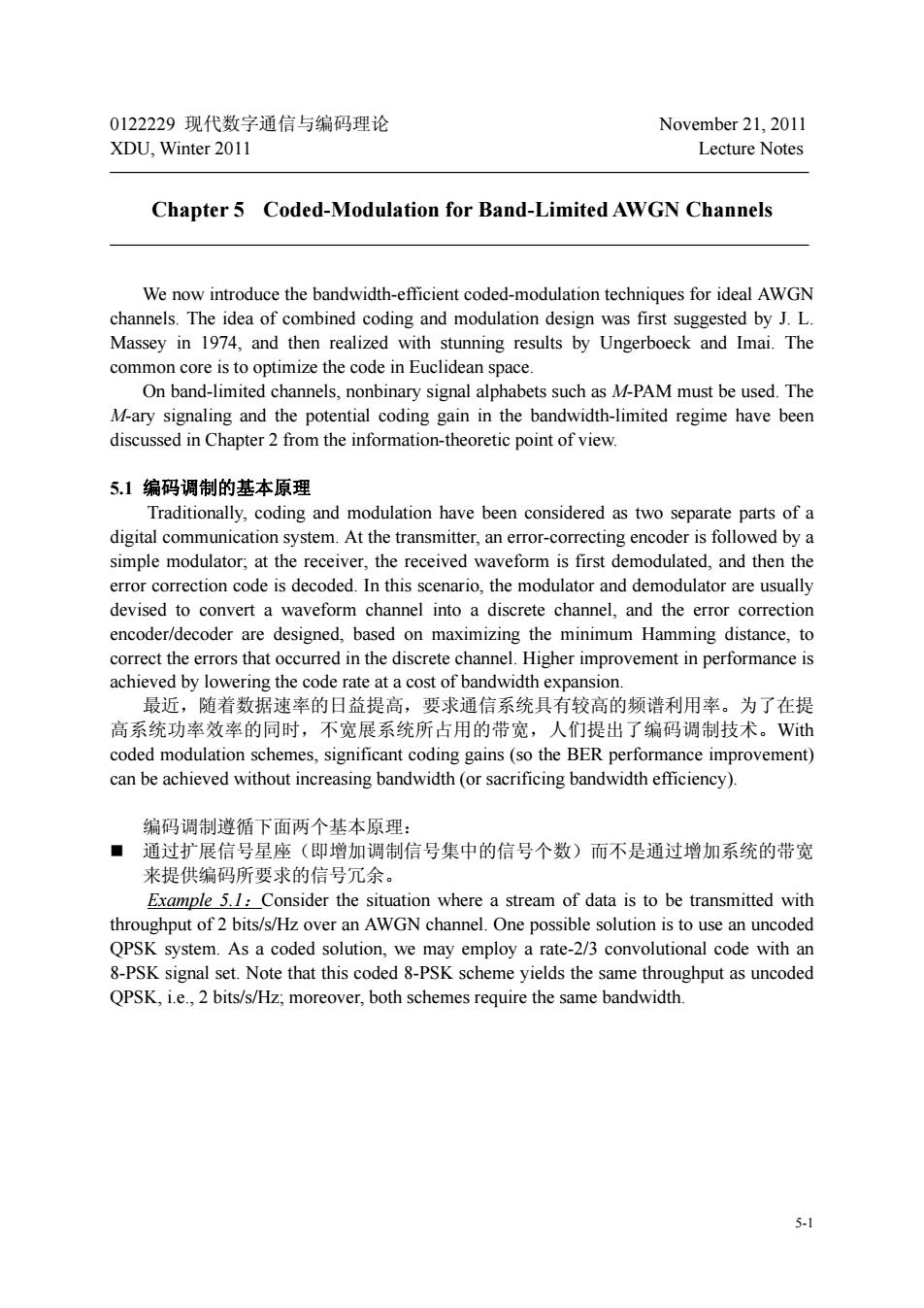正在加载图片...

0122229现代数字通信与编码理论 November 21,2011 XDU,Winter 2011 Lecture Notes Chapter 5 Coded-Modulation for Band-Limited AWGN Channels We now introduce the bandwidth-efficient coded-modulation techniques for ideal AWGN channels. The idea of combined coding and modulation design was first suggested by J.L Massey in 1974,and then realized with stunning results by Ungerboeck and Imai.The common core is to optimize the code in Euclidean space. On band-limited channels,nonbinary signal alphabets such as M-PAM must be used.The M-ary signaling and the potential coding gain in the bandwidth-limited regime have been discussed in Chapterfrom the information-theoretic point of view 5.1编码调制的基本原理 Traditionally,coding and modulation have been considered as two separate parts of a simple modul ator,at th rec the received wa eform is first de odulated,and the error correction code is decoded.In this scenario,the modulator and demodulator are usually devised to convert a waveform channel into a discrete channel,and the error correction encoder/decoder are designed,based on maximizing the minimum Hamming distance,to correct the errors that occurred in the discrete channel.Higher improvement in performance is ved by l a the 最近,随者数 速率的日益提高 要求通信系统具有较高的频谱利用率。为了在提 高系统功率效率的同时,不宽展系统所占用的带宽,人们提出了编码调制技术。Wh coded modulation schemes,significant coding gains(so the BER performance improvement) can be achieved without increasing bandwidth(or sacrificing bandwidth efficiency) 编码调制遵循下面两个基本原理: 通过扩展信号星月 (即增加调制信号集中的信号个数)而不是通过增加系统的带宽 来提供编码所要求的信号元余。 Example 5.1:Consider the situation where a stream of data is to be transmitted with throughput of 2 bits/s/Hz over an AWGN channel.One possible solution is to use an uncoded syste em.As a coded solutior mploy a rate-2/3 convolutional code with QPSK,i.e.,2 bits/s/Hz;moreover,both schemes require the same bandwidth. 5-1 5-1 0122229 现代数字通信与编码理论 November 21, 2011 XDU, Winter 2011 Lecture Notes Chapter 5 Coded-Modulation for Band-Limited AWGN Channels We now introduce the bandwidth-efficient coded-modulation techniques for ideal AWGN channels. The idea of combined coding and modulation design was first suggested by J. L. Massey in 1974, and then realized with stunning results by Ungerboeck and Imai. The common core is to optimize the code in Euclidean space. On band-limited channels, nonbinary signal alphabets such as M-PAM must be used. The M-ary signaling and the potential coding gain in the bandwidth-limited regime have been discussed in Chapter 2 from the information-theoretic point of view. 5.1 编码调制的基本原理 Traditionally, coding and modulation have been considered as two separate parts of a digital communication system. At the transmitter, an error-correcting encoder is followed by a simple modulator; at the receiver, the received waveform is first demodulated, and then the error correction code is decoded. In this scenario, the modulator and demodulator are usually devised to convert a waveform channel into a discrete channel, and the error correction encoder/decoder are designed, based on maximizing the minimum Hamming distance, to correct the errors that occurred in the discrete channel. Higher improvement in performance is achieved by lowering the code rate at a cost of bandwidth expansion. 最近,随着数据速率的日益提高,要求通信系统具有较高的频谱利用率。为了在提 高系统功率效率的同时,不宽展系统所占用的带宽,人们提出了编码调制技术。With coded modulation schemes, significant coding gains (so the BER performance improvement) can be achieved without increasing bandwidth (or sacrificing bandwidth efficiency). 编码调制遵循下面两个基本原理: 通过扩展信号星座(即增加调制信号集中的信号个数)而不是通过增加系统的带宽 来提供编码所要求的信号冗余。 Example 5.1:Consider the situation where a stream of data is to be transmitted with throughput of 2 bits/s/Hz over an AWGN channel. One possible solution is to use an uncoded QPSK system. As a coded solution, we may employ a rate-2/3 convolutional code with an 8-PSK signal set. Note that this coded 8-PSK scheme yields the same throughput as uncoded QPSK, i.e., 2 bits/s/Hz; moreover, both schemes require the same bandwidth